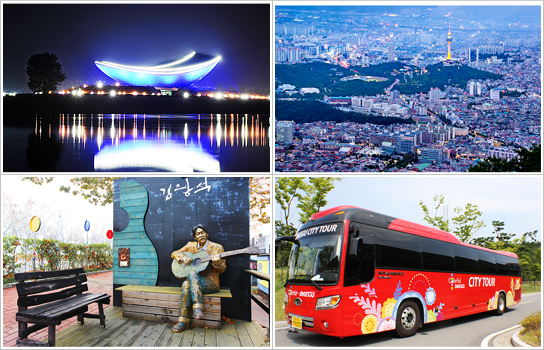
Proud host of the IAAF World Championships in 2011, Daegu is one of Korea's six major metropolitan cities and home to the Bullo-dong Ancient Tomb Park, the largest concentration of ancient tombs in all of Korea. Other main attractions include theDaegu Bangjja Brassware Museum, one of Korea’s traditional cultural assets. Each tour bus guides provide a thorough explanation of each attraction.
| Courses
•City Circulation Course
Hours of Operation: 09:30 – 17:30, 90 minute-intervals, 5 departures daily
Operation Schedule: In operation year around (no tours on Mondays or major holidays)
Departure Point: Daegu City Tour Bus Stop in front of Dongdaegu Station
Itinerary: Dongdaegu Station → Gukchaebosang Memorial Park (formerly Dongin Park) → 2.28 Park·Daegu Dongseongno Street → Yangnyeongsi → Modern Culture Street (Medical Missionary Museum) → Daegu Duryu Park → Seo-gu District Office →Seomun Market → Daegu Dalseong Park·Samsung Firm Site → Daegu Citizens' Hall·Jungang-ro → Bongsan Culture Street → Sincheon Stream·Kim Gwangseok-gil → Beomeo Station·The Grand Daegu Hotel Duty Free Shop → Dongdaegu Station
•Palgongsan Circulation Course
Hours of Operation: 09:30 – 17:00, once a day
Operation Schedule: Tuesday – Sunday, (no tours on Mondays or major holidays)
Departure Point: In front of Banwoldang Hyundai Department Store (departs at 09:30), Daegu City Tour Bus Stop in front of Dongdaegu Station (departs at 10:00)
Itinerary: Banwoldang → Dongdaegu Station → Bullo-dong Ancient Tomb Park (Dong-gu Crafts Exhibition Hall) → Daegu Bangjja Brassware Museum → Donghwasa Temple (Daegu) → Daegu Safety Theme Park → Dongdaegu Station → Banwoldang
•Themed Course
Hours of Operation: 10:00 – 16:00, once a day
Operation Schedule: In operation year round including weekends, national holidays and major holidays
Departure Point: In front of Banwoldang Hyundai Department Store
Itinerary:
①Year-round: Traditional 5-day market, casual life safety experience program, tea ceremony, tofu-making, making a pot for wildflowers
②Spring: Biseulsan Azalea Festival, Daegaya Festival, strawberry picking
③Summer: loach-catching, making bamboo water guns, summer apple picking
④Autumn: digging sweet potatoes, autumn apple picking, plum picking
⑤Winter: Biseulsan Ice Festival, kite-making, taffy-making, making oil and honey pastries
※Schedules of the themed course are subject to change monthly, so please check the schedule on the website.
•History Tour Course
Hours of Operation: 10:00 – 16:00, once a day
Operation Schedule: Tuesday & Friday
Departure Point: In front of Banwoldang Hyundai Department Store
Itinerary: Banwoldang → Daegu National Museum → Inheung Village → Daegu Modern History Museum → Daegu Yangnyeongsi Oriental Medicine Cultural Center → Banwoldang
•Traditon & Culture Course
Hours of Operation: 10:00 – 16:00, once a day
Operation Schedule: Monday & Tuesday
Departure Point: In front of Banwoldang Hyundai Department Store
Itinerary: Banwoldang → Nokdongseowon Confucian Academy·Dalseong Korea Japan Friendship Center → Kim Gwangseok-gil → Head Household of the Gyeongju Choe Clan in Otgol Village → Medical Missionary Museum → Banwoldang
•Science & Environment Course
Hours of Operation: 10:00 – 16:00, once a day
Operation Schedule: Wednesday & Saturday
Departure Point: In front of Banwoldang Hyundai Department Store
Itinerary: Banwoldang → Daegu Arboretum → Daegu Environment Resource Office → Munsan Filtration Plant → Gangjeong Goryeong Reservoir for Irrigation (The ARC) → Banwoldang
Hours of Operation: 09:30 – 17:30, 90 minute-intervals, 5 departures daily
Operation Schedule: In operation year around (no tours on Mondays or major holidays)
Departure Point: Daegu City Tour Bus Stop in front of Dongdaegu Station
Itinerary: Dongdaegu Station → Gukchaebosang Memorial Park (formerly Dongin Park) → 2.28 Park·Daegu Dongseongno Street → Yangnyeongsi → Modern Culture Street (Medical Missionary Museum) → Daegu Duryu Park → Seo-gu District Office →Seomun Market → Daegu Dalseong Park·Samsung Firm Site → Daegu Citizens' Hall·Jungang-ro → Bongsan Culture Street → Sincheon Stream·Kim Gwangseok-gil → Beomeo Station·The Grand Daegu Hotel Duty Free Shop → Dongdaegu Station
•Palgongsan Circulation Course
Hours of Operation: 09:30 – 17:00, once a day
Operation Schedule: Tuesday – Sunday, (no tours on Mondays or major holidays)
Departure Point: In front of Banwoldang Hyundai Department Store (departs at 09:30), Daegu City Tour Bus Stop in front of Dongdaegu Station (departs at 10:00)
Itinerary: Banwoldang → Dongdaegu Station → Bullo-dong Ancient Tomb Park (Dong-gu Crafts Exhibition Hall) → Daegu Bangjja Brassware Museum → Donghwasa Temple (Daegu) → Daegu Safety Theme Park → Dongdaegu Station → Banwoldang
•Themed Course
Hours of Operation: 10:00 – 16:00, once a day
Operation Schedule: In operation year round including weekends, national holidays and major holidays
Departure Point: In front of Banwoldang Hyundai Department Store
Itinerary:
①Year-round: Traditional 5-day market, casual life safety experience program, tea ceremony, tofu-making, making a pot for wildflowers
②Spring: Biseulsan Azalea Festival, Daegaya Festival, strawberry picking
③Summer: loach-catching, making bamboo water guns, summer apple picking
④Autumn: digging sweet potatoes, autumn apple picking, plum picking
⑤Winter: Biseulsan Ice Festival, kite-making, taffy-making, making oil and honey pastries
※Schedules of the themed course are subject to change monthly, so please check the schedule on the website.
•History Tour Course
Hours of Operation: 10:00 – 16:00, once a day
Operation Schedule: Tuesday & Friday
Departure Point: In front of Banwoldang Hyundai Department Store
Itinerary: Banwoldang → Daegu National Museum → Inheung Village → Daegu Modern History Museum → Daegu Yangnyeongsi Oriental Medicine Cultural Center → Banwoldang
•Traditon & Culture Course
Hours of Operation: 10:00 – 16:00, once a day
Operation Schedule: Monday & Tuesday
Departure Point: In front of Banwoldang Hyundai Department Store
Itinerary: Banwoldang → Nokdongseowon Confucian Academy·Dalseong Korea Japan Friendship Center → Kim Gwangseok-gil → Head Household of the Gyeongju Choe Clan in Otgol Village → Medical Missionary Museum → Banwoldang
•Science & Environment Course
Hours of Operation: 10:00 – 16:00, once a day
Operation Schedule: Wednesday & Saturday
Departure Point: In front of Banwoldang Hyundai Department Store
Itinerary: Banwoldang → Daegu Arboretum → Daegu Environment Resource Office → Munsan Filtration Plant → Gangjeong Goryeong Reservoir for Irrigation (The ARC) → Banwoldang
Daegu City Tour Information
☞ Departure Point: In front of Banwoldang Hyundai Department Store (In front of Dongdaegu Station for the City Circulation Course)
※ For the Palgongsan Course, it is also possible to board the bus in front of Dongdaegu Station at 10:00
☞ Fees: 5,000 won for adults/ 4,000 won for teens/ 3,000 won for kids
※ Fees for admission, hands-on programs and meals are excluded (Tour participants must bring their own lunch for the Themed Course)
※ A 40% discount is available for those holding KTX, Saemaeul or Mugunghwa Train day tickets and a 20% discount is available for those holding an express bus day ticket. No discount advantages for other courses.
☞ Reservations and inquiries:
[City Circulation Course]
Daegu Infrastructure Corporation 2-Story Bus City Tour Homepage (Korean)
Daegu Infrastructure Corporation: +82-53-603-1800 (Korean, English)
[Other Courses]
Daegu City Tour Homepage (Korean, English, Japanese, Chinese)
Samsung Plus Tour: +82-53-627-8900 (Korean, English, Chinese)
※ Online reservation or phone reservation are mandatory.
☞ 1330 Korea Travel Hotline: +82-2-1330(Korean, English, Japanese, Chinese)
※ For the Palgongsan Course, it is also possible to board the bus in front of Dongdaegu Station at 10:00
☞ Fees: 5,000 won for adults/ 4,000 won for teens/ 3,000 won for kids
※ Fees for admission, hands-on programs and meals are excluded (Tour participants must bring their own lunch for the Themed Course)
※ A 40% discount is available for those holding KTX, Saemaeul or Mugunghwa Train day tickets and a 20% discount is available for those holding an express bus day ticket. No discount advantages for other courses.
☞ Reservations and inquiries:
[City Circulation Course]
Daegu Infrastructure Corporation 2-Story Bus City Tour Homepage (Korean)
Daegu Infrastructure Corporation: +82-53-603-1800 (Korean, English)
[Other Courses]
Daegu City Tour Homepage (Korean, English, Japanese, Chinese)
Samsung Plus Tour: +82-53-627-8900 (Korean, English, Chinese)
※ Online reservation or phone reservation are mandatory.
☞ 1330 Korea Travel Hotline: +82-2-1330(Korean, English, Japanese, Chinese)
| Major Tourist Attractions
Dalseong Dodongseowon Confucian Academy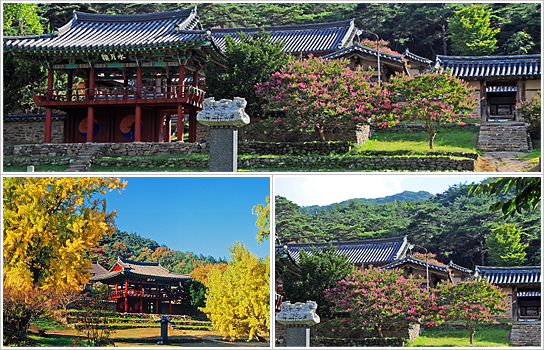
Dalseong Dodongseowon Confucian Academy is a private educational institution that was established during the mid-Joseon Period (1392-1910). It is one of the five major seowon (Confucian academies) in Korea along with Byeongsanseowon Confucian Academy, Oksanseowon Confucian Academy, Sosuseowon Confucian Academy, andDosanseowon Confucian Academy. The most noted features of Dodongseowon include its lecture hall, a shrine, and a 400-year-old gingko tree that thrives in the yard outside. The beautiful earthen wall decorated with roof tiles at the academy was designated a national treasure (National Treasure No. 350) along with the lecture hall and the shrine.
☞ Dalseong Dodongseowon Confucian Academy
☞ Daegu U-Tourpia Homepage(Korean, English, Japanese, Chinese)
☞ Dalseong-gun Homepage(Korean)
☞ Daegu U-Tourpia Homepage(Korean, English, Japanese, Chinese)
☞ Dalseong-gun Homepage(Korean)
Nokdongseowon Confucian Academy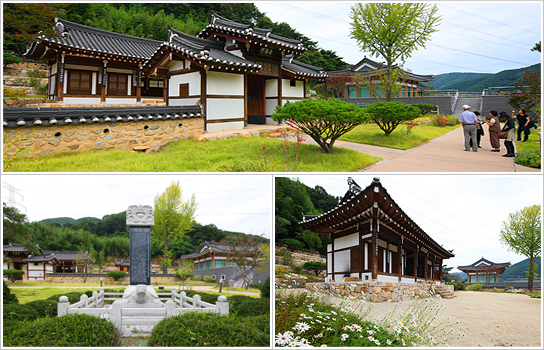
Nokdongseowon Confucian Academy was built to commemorate Mohadang Kim Chung-Seon (1571-1642), a Japanese general who became naturalized as a Korean citizen during the Imjin War (1592-1598). Located on the academy grounds are a shrine, the Korea-Japan Cultural Exchange Center, and a monument dedicated to General Kim.
☞ Nokdongseowon Confucian Academy
☞ Daegu U-Tourpia Homepage (Korean, English, Japanese, Chinese)
☞ Dalseong Korea Japan Friendship Center
k (Korean, English, Japanese)
☞ Daegu U-Tourpia Homepage (Korean, English, Japanese, Chinese)
☞ Dalseong Korea Japan Friendship Center
k (Korean, English, Japanese)
Daegu Yangnyeongsi Oriental Medicine Cultural Center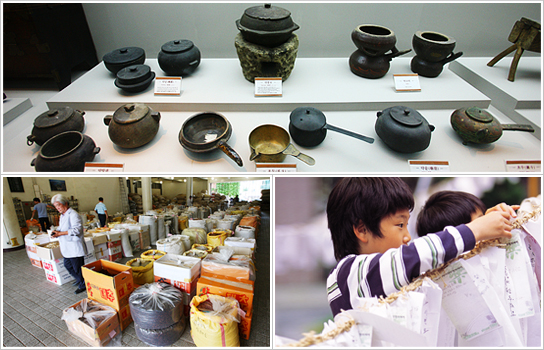
Daegu Yangnyeongsi Oriental Medicine Cultural Center offers visitor an all-inclusive look into the world of Oriental medicine. The herbal medicine wholesale market (1F) is open on the 1st, 6th, 11th, 16th, 21st and 26th every month, and sells herbal medicine from all across the country. At the oriental medicine experience hall on the second floor, visitors can take part in hands-on programs such as hanbok wearing, wrapping herb medicine, oriental medicinal soap making, and an oriental medicinal foot bath. The oriental medicine history hall is located on the third floor with other exhibits including a reenactment of the 1910s-era Yangjeon Medicine Alley.
☞Daegu Yangnyeongsi Oriental Medicine Cultural Center
☞Daegu Yangnyeongsi Oriental Medicine Cultural Center Homepage (Korean, English, Japanese, Chinese)
☞Daegu Yangnyeongsi Oriental Medicine Cultural Center Homepage (Korean, English, Japanese, Chinese)
Palgongsan Mountain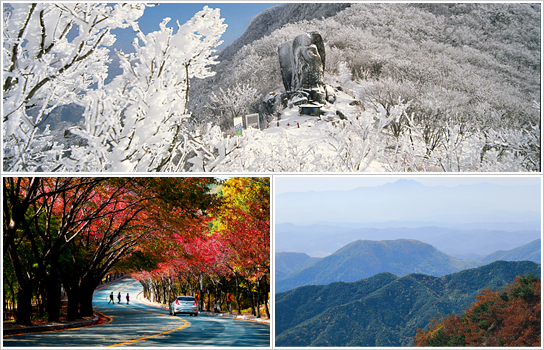
Palgongsan Mountain is considered the center of Buddhist culture in Korea. The mountain offers plenty of things to see all year round thanks to the lush trees and scenic rocks and valleys that cover the mountain. Treasured not only for its natural beauty, the mountain also hides within its folds a number of old temples and historic sites from the Silla Dynasty (57 BC – 935 AD). Main points of interest along the mountain include Gwangbong Seated Stone Buddha (Gatbawi Rock), Wonhyosa Temple, Cheonseongsa Temple, and Bulguksa Temple.
☞ Palgonsan Natural Park (Gatbawi District)
☞ Palgonsan Natural Park Homepage(Korean, English, Japanese, Chinese)
☞ Seonbonsa Temple
☞ Seonbonsa Temple Homepage (Korean)
☞ Palgonsan Natural Park Homepage(Korean, English, Japanese, Chinese)
☞ Seonbonsa Temple
☞ Seonbonsa Temple Homepage (Korean)
Bullo-dong Ancient Tomb Park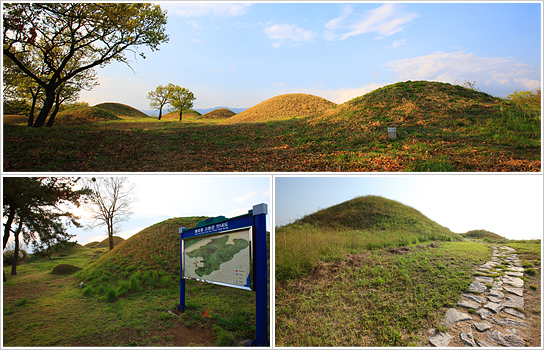
Bullo-dong Ancient Tomb Park boasts over 211 tombs dating back to the Three Kingdoms Period (57 BC – 668 AD). The tombs in this particular park are recognized as having the most well-preserved mounds among all the surviving ancient tombs of Daegu. The tombs are concentrated within a relatively small area of land and provide visitors with a rare (and convenient) glimpse into ancient society.
Daegu Bangjja Brassware Museum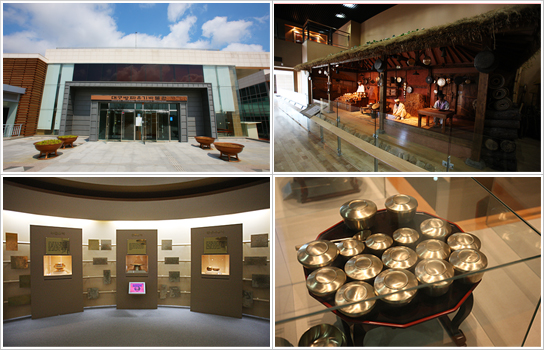
Located at the foot of Palgongsan Mountain, Daegu Bangjja Brassware Museum is the first museum in Korea to specialize in brassware. The museum was founded with the goal of preserving the delicate art of Bangjja Yugi (Korean brassware) and to educate future generations on the meticulous crafting process. The museum houses three exhibition rooms (Yugi Room, Donated Items Room, and Reproduction Room), a video education room, an outdoor performance stage, and a temporary exhibition room.
☞ Daegu Bangjja Brassware Museum
☞ Daegu Bangjja Brassware Museum Homepage (Korean, English, Japanese, Chinese)
☞ Daegu Bangjja Brassware Museum Homepage (Korean, English, Japanese, Chinese)
Daegu National Museum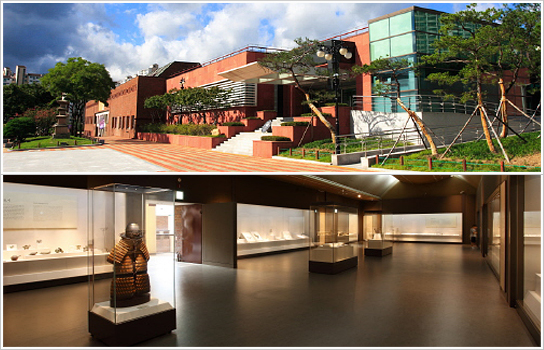
The Daegu National Museum proudly displays items related to the distinctive cultural heritage of Daegu City and Gyeongsangbuk-do. Museum exhibits detail various aspects of the local culture such as the history of the region throughout the prehistoric age and the Three Kingdoms Period (57 BC–668 AD), Buddhist culture, Confucian culture and local housing culture. Hands-on experience programs such as making earthenware and playing folk games are available for guests as well as a variety of culture and arts classes, events, and performances.
Comments
Post a Comment